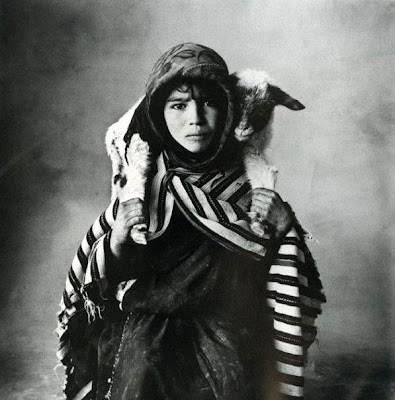A young Berber shepherdess of the Aït Yazza people in the High Atlas, with a newborn lamb.
"Taking people away from their natural circumstances and putting them into the studio in front of a camera did not simply isolate them, it transformed them. Sometimes the change was subtle; sometimes it was great enough to be almost shocking. But always there was transformation. As they crossed the threshold of the studio, they left behind some of the manners of their community, taking on a seriousness of self-presentation that would not have been expected of simple people. ...the one characteristic all these various people seem to have in common is that they rose to the experience of being looked at by a stranger, in most cases from another culture, with dignity and a seriousness of concentration that they would never have had ten or fifteen feet away, outside the studio, in their own surroundings.
The studio became, for each of us, a sort of neutral area. It was not their home, as I had brought this alien enclosure into their lives; it was not my home, as I had obviously come from elsewhere, far away. But in this limbo there was for us both the possibility of contact that was a revelation to me and often, I could tell, a moving experience for the subjects themselves, who without words - by only their stance and their concentration - were able to say much that spanned the gulf between our different worlds."
Two Peruvian country children, brother and sister, dressed for a visit to Cuzco. The piano stool tells something of their tiny size (originally intended as the cover photo of Cahoots).
Cuzco Children, Peru, Christmas (1948)
Irving Penn (1917~2009), taken by another great American portraitist, Bert Stern, in the 1960s. (image via)






,+1967.jpg)

+-+two+Peruvian+children,+originally+intended+as+the+cover+photo+of+Cahoots.jpg)
.jpg)

,+1970.jpg)


























